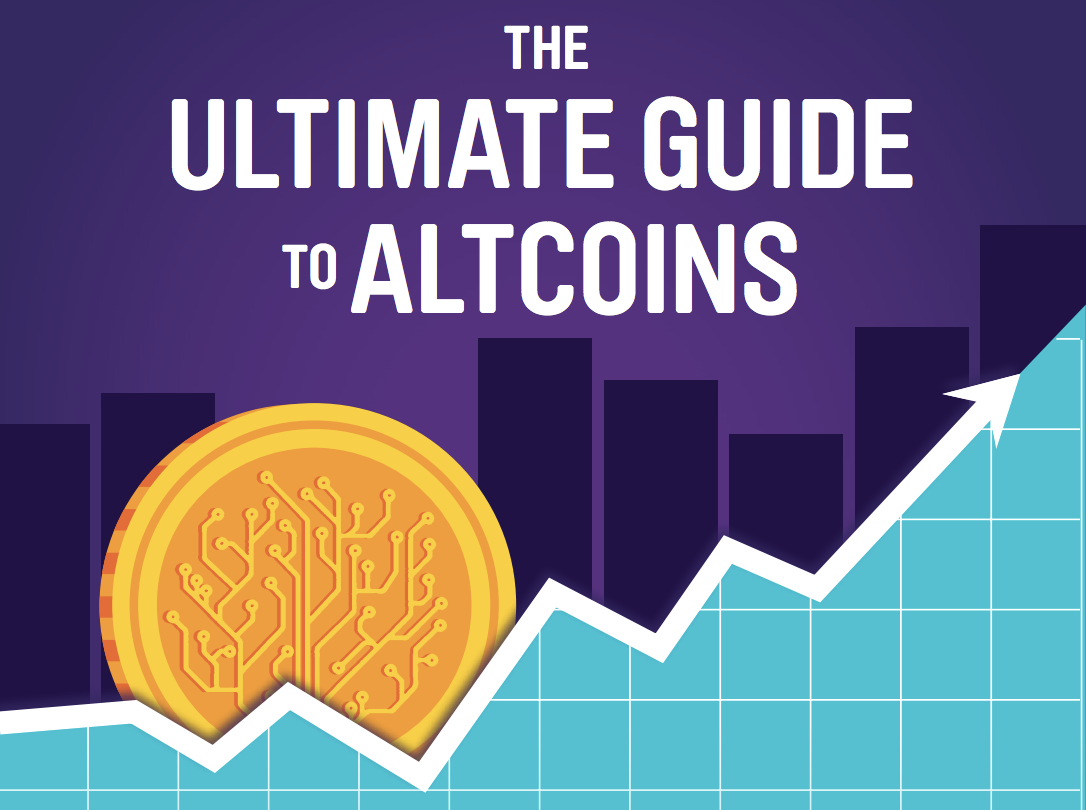We wanted to share some more great news with you. We’ve released the Ultimate Altcoin Guide!
The title kind of gives it away, but the guide was created to provide some deeper background on what altcoins are and why they are important.
A quick spoiler: Altcoins have been gaining market traction over the past couple of years when compared to bitcoin’s market dominance. The Ultimate Altcoin Guide gives some context and background on ten different altcoins.
This guide is perfect for anyone trying to do their own research about altcoin prices, altcoin possibilities, or altcoin investment opportunities.
The Ultimate Altcoin Guide was created for informational purposes only and is not intended to provide any kind of financial advice.
If this sounds good so far, then there’s no need to read on. You can find out how to download the altcoin guide here.
What is an altcoin?
The word altcoin generally refers to any cryptocurrency coin or token that is not Bitcoin.
Bitcoin was the first massively-adopted cryptocurrency. Soon after, forks of Bitcoin, or different variations of the underlying open-source blockchain, were created for other purposes.
Litecoin, for example, which is one popular cryptocurrency, was created as a fork of the Bitcoin blockchain. Litecoin was designed to process transactions faster than bitcoin by making use of a different hashing algorithm. The original version of Bitcoin was modified into other forms of cryptocurrency too. Other cryptocurrencies were created in a similar way, optimizing for privacy, or for other attributes.
So that’s where the word altcoin first came from. In the early days of crypto, many of the available coins were viewed as alternatives to Bitcoin’s main network.
But the story doesn’t end there. Today, there are more than 1,600 different cryptocurrencies available being traded in more than 11,000 different markets.
As the size of the cryptocurrency market continues to grow, so does the number of altcoins.
And they are no longer just forks of Bitcoin. Today, altcoins are being designed and developed with all kinds of unique architectures, and with specific utilities in mind.
Some altcoins, like Ethereum and NEO, are built as massive networks that power smart contracts, which can be used to power decentralized applications. Developers are also creating specialty coins that are attached to digital economies such as file sharing, or predictive markets.
What does the Ultimate Altcoin Guide cover?
The Ultimate Altcoin Guide provides background about the kinds of problems individual altcoins are trying to solve and some additional information about the team that created the altcoin, or more specifics about the technology underlying each system.
These are the altcoins covered in the guide:
| coin | symbol | description |
| Ethereum | ETH | Launched in 2015, Ethereum is a blockchain designed to support the building of decentralized applications. Individual units of Ethereum cryptocurrency are called ether. |
| Monero | XMR | Launched in 2014, Monero is a privacy-centric coin and blockchain. Like Bitcoin, Monero uses a proof-of-work system to maintain its ledger and create new coins. Monero’s transactions are cloaked by algorithms that protect user identity and transaction details. |
| Litecoin | LTC | Litecoin was launched in 2011 as a faster and cheaper alternative to Bitcoin. Litecoin is a fork, or a modification, on Bitcoin’s network, and it is more cost-effective than Bitcoin to use for everyday transactions. |
| Ripple | XRP | Ripple is the name of the company founded in 2012 and that has created what is known as the Ripple Protocol, as well as the XRP token. Ripple’s goal is to create a global, enterprise-scale blockchain solution for handling payments across borders with no chargebacks. This type of service is designed primarily for banks, payment providers, and other financial institutions. |
| Stellar Lumens | XLM | Launched in 2014 by the nonprofit, the Stellar Development Foundation, the Stellar network is designed to create financial infrastructure for developing economies by enabling low-cost transactions. Units of Stellar, called lumens, enable micro-transactions and allow different financial platforms to become compatible. |
| Dash | DASH | Launched in 2014 as a fork of Bitcoin, Dash is trying to make smaller financial transactions possible on blockchain. Dash is also privacy-focused, and obscures details of users’ transactions, making them difficult to track or trace. |
| Ethereum Classic | ETC | Ethereum Classic is the original version of the Ethereum blockchain, which was forked in July 2016 to undo a digital heist of $50 million of ether (in 2016 values). Part of the community that supported recovering the hacked funds by reversing the transactions on the blockchain supported the fork that is now known as Ethereum. Proponents of the maintaining the immutability created Ethereum Classic. |
| QTUM | QTUM | Launched in 2017, Qtum ranks in the top 25 of cryptocurrencies and bills itself as the world’s first blockchain made ready for business. Qtum can be best thought of as a hybrid between Bitcoin and Ethereum, taking good parts from both, and creating a new and accessible place for businesses to launch distributed applications built on smart contracts. |
| NEO | NEO | Rebranded as NEO in 2017, and previously known as Antshares, NEO is focused on building a distributed smart economy, organized by on digital assets, the verification of digital identities, and smart contracts. |
| ZCash | ZEC | Launched in 2016, ZCash is another privacy-oriented blockchain that is a fork of the Bitcoin protocol. ZCash is based on zero-knowledge proofs, which protect user security and also enhance fungibility. |
Interested? Get more info and download the Ultimate Altcoin Guide here.
About Abra
Established in 2014, Abra is on a mission to create a simple and honest platform that enables millions of cryptocurrency holders to maximize the potential of their assets. Abra enables both individuals and businesses to safely and securely buy, trade, and borrow against cryptocurrencies – all in one place. Abra’s vision is an open, global financial system that is easily accessible to everyone.
Why Abra
Based in the United States, Abra is available in over 150 countries and makes it easy to convert between crypto and a wide variety of local fiat currencies. With over 2MM customers, $7B in transactions processed, and $1.5B in assets under management, Abra continues to grow rapidly. Abra is widely loved and trusted – in April 2022, pymnts.com reviewed and rated Abra amongst the top 5 most popular crypto wallets in the market. Abra is backed by top-tier investors such as American Express Ventures and First Round Capital.
How Abra Protects Your Funds
Abra places clients’ financial objectives and security first. Abra practices a culture of risk management across all levels and functions within the organization.
Abra employs a state-of-the-art enterprise risk management framework that comprises a comprehensive set of policies, procedures, and practices detailing all applicable risk-related objectives and constraints for the entirety of the business. Abra has instituted a complete set of requisite systems and controls that continuously enforce these policies, procedures, and practices to manage all operations, including credit and lending. Abra’s independent Risk Committee comprises experienced compliance, risk, securities, and fraud operations professionals with backgrounds in industries ranging from traditional and digital assets banking, payments, remittance, to fintech.
Please visit our FAQ to learn more.




Blog tiền điện tử
2067 days agoaltcoin is a more improved currency, learn thoroughly before investing